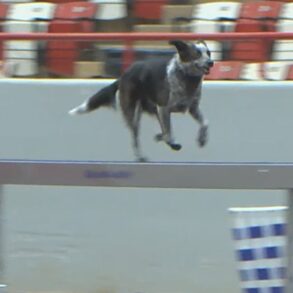
Last month, I pointed to an article in BBC Science Focus that conflated animal use of stone tools with the Stone Age in a way that suggested some sort of equivalence between animal and human behavior. This is routine in science writing today, and it often relates poorly to the evidence at hand. For example, Stonehenge is different, not merely in degree but in kind, from bonobos smashing nuts open with stones.
Here’s Another Example
At Live Science, science writer Marilyn Perkins asks, “Are cats and dogs smarter than babies?”
It’s an odd question because what we should be asking is, “Are kittens and puppies smarter than babies?” Maybe in one sense they are; they certainly mature faster. But their intellectual development just stops after a year or two and no more heights are scaled. So we are comparing apples and rockets. Still, we must look at the question as it was given.
The go-to academic for this is emeritus University of British Columbia psychology prof Stanley Coren, whose specialty is dog intelligence. He even adapted the psychological concept of “mental age” to compare dogs’ cognitive abilities to those of humans:
While it’s not possible to draw an exact comparison between dog and human intelligence, Coren said dogs do have some cognitive skills, such as vocabulary and counting, that roughly correspond to those of young toddlers. For example, the average dog can understand about 165 words and signals. In exceptional cases, some dogs can learn significantly more. For example, Chaser the border collie, who was specially trained by a retired psychology professor, was reported to understand over 1,000 words.
“Are cats and dogs smarter than babies?,” January 4, 2025
It is certainly not possible to draw an exact comparison because the child is preparing to understand abstract principles and recursive language; the dog is not. The adult dog understands language as a signal system, not a symbolic system. So some dogs can learn more signals than others but no dog will have a conversation with you about God or the Big Bang. Yet by about seven to ten years of age, many, if not most, children are capable of asking “Where did it all come from?”
Math Skills?
Can dogs count? Coren says they can generally “count” up to 3:
If the idea of a dog being able to count sounds unlikely to you, try this: Show your dog three treats, hide them all in your hand, and then give the dog only two. Most dogs will know one treat is still missing and nuzzle your hand to try finding it…
Coren added that trained retrievers, which are bred to fetch downed birds or other game, often keep track of five or more objects in order while hunting. So, even though dogs can’t recite “one, two, three,” like a preschooler might, these sorts of behaviors show that many dogs have some intrinsic understanding of basic counting.
Actually, the dogs probably aren’t counting. If they can hold three or five objects in their attention for a requisite amount of time, they don’t need to count. Counting becomes important precisely when we can no longer do that. Then we resort to counting by threes, fives, tens, or whatever. But that requires the ability to understand numbers as abstractions, which will take the toddler some time. But the dog, however clever, is just not headed in that direction.
Dogs and Mental Age
Coren offers an estimate of dog intelligence in terms of human age:
By analyzing these sorts of cognitive functions, you can estimate the “mental age” of dogs on a human scale, Coren said. “We basically found out that the average dog has a mental age which is about the equivalent of a 2-and-a-half-year-old child,” at least when it comes to certain cognitive skills such as vocabulary, counting and emotional awareness, he told Live Science. He said for different dogs, the number can range from about age 2 to 3.
For those who like numbers, this may seem a satisfying result but it is an empty measure. The human child is preparing to understand abstract thought, while picking practical things up along the way — some language, some numbers, some behavior rules… The adult dog is functioning at its highest level of intelligence — a concrete, not an abstract one.
It’s an interesting article, to be sure. But it’s hard to know what is achieved by a comparison between the two types of intelligence. The comparison doesn’t really work but it underlines the doctrine that human intelligence is just another type of animal intelligence. As a doctrine, that view is not generally defended directly, but mostly by implication — as in this case.
Next: Cat intelligence compared with baby intelligence.
Cross-posted at Mind Matters News.
This post was originally published on this site be sure to check out more of their content.













































